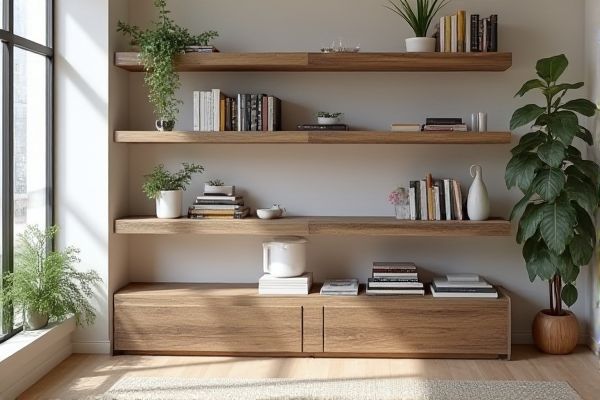
Shelf risers maximize vertical space by elevating items on a single shelf, ideal for small items or creating tiers, while stacking shelves provide multiple levels for storing larger objects, offering more substantial storage capacity. Discover which option best suits your storage needs by reading the detailed comparison in the article ahead.
Table of Comparison
| Feature | Shelf Risers | Stacking Shelves |
|---|---|---|
| Definition | Elevated platforms placed on existing shelves to increase vertical space. | Individual shelves designed to stack on top of each other, creating multi-level storage units. |
| Material | Typically plastic, metal, or wood. | Usually metal, wood, or plastic frames. |
| Installation | No tools needed; simply placed on shelves. | Requires assembly; may need tools to stack securely. |
| Space Optimization | Maximizes vertical space within existing shelves. | Creates additional full shelf units, expanding storage height. |
| Weight Capacity | Supports moderate weight depending on material and design. | Typically supports heavier loads due to sturdier construction. |
| Flexibility | Easy to reposition and remove. | More permanent; less flexible once assembled. |
| Common Uses | Kitchen cabinets, desks, closets for organizing small items. | Garages, warehouses, and larger spaces for heavy or bulk storage. |
| Price Range | Generally lower cost ($10-$30). | Higher cost due to materials and size ($50-$200+). |
Introduction to Shelf Risers and Stacking Shelves
Shelf risers elevate items to maximize vertical storage space, creating multiple levels within a cabinet or closet for improved organization. Stacking shelves are modular units designed to be placed directly on top of existing shelves or surfaces, effectively increasing storage capacity by utilizing unused vertical space. Both solutions optimize storage efficiency by enhancing accessibility and reducing clutter in various environments.
What Are Shelf Risers?
Shelf risers are elevated platforms designed to create additional vertical space within cabinets, closets, or shelves by raising items above the base surface, optimizing storage capacity. Constructed from materials like wood, metal, or plastic, they provide sturdy support for organizing dishes, pantry goods, or office supplies without clutter. Unlike stacking shelves which add layers, shelf risers specifically focus on lifting existing shelves or objects to enhance accessibility and maximize spatial efficiency.
What Are Stacking Shelves?
Stacking shelves are modular storage units designed to be placed directly on top of each other, maximizing vertical space without the need for permanent installation. They typically feature sturdy construction with open or enclosed compartments, allowing for efficient organization and easy access to items. Ideal for closets, kitchens, or offices, stacking shelves enhance storage capacity while maintaining stability and flexibility.
Key Differences Between Shelf Risers and Stacking Shelves
Shelf risers elevate items by providing vertical space between levels, enhancing visibility and easy access to stored objects, while stacking shelves create entirely separate tiers that can be removed or rearranged independently. Shelf risers are typically lightweight and designed to fit inside existing shelves, ideal for maximizing space without altering shelf structure. Stacking shelves are sturdier, often freestanding, and allow greater flexibility in customizing storage height and configuration.
Space Optimization: Which Saves More Room?
Shelf risers enhance vertical storage by creating additional tiers within existing shelves, maximizing underutilized height without increasing footprint. Stacking shelves provide modular platforms that multiply storage layers but can consume more horizontal space due to their bulk and stability requirements. For tight spaces, shelf risers generally offer superior space optimization by efficiently leveraging vertical clearance with minimal desk or cabinet intrusion.
Installation and Ease of Use
Shelf risers require minimal installation, often just placing them directly onto an existing shelf, making them quick and easy to use. Stacking shelves may need more setup, such as aligning and securing additional layers for stability, which can be less convenient. Your choice depends on whether you prioritize fast, tool-free application or customizable vertical storage expansion.
Durability and Material Considerations
Shelf risers often feature sturdy materials like solid wood or heavy-duty plastic, enhancing durability for heavy items or frequent use. Stacking shelves are typically constructed from lighter metals or composite materials, which might compromise long-term strength but offer versatility and easier stacking. When prioritizing durability, selecting shelf risers with reinforced joints and high-quality finishes ensures a longer lifespan compared to some stacking shelf designs prone to bending or wear.
Versatility and Best Usage Scenarios
Shelf risers offer superior versatility by providing adjustable height options that accommodate various item sizes, making them ideal for organizing kitchen cabinets, closets, and office spaces. Stacking shelves excel in creating additional horizontal storage within confined areas, perfect for small apartments or dorm rooms where maximizing vertical space is essential. Choosing between shelf risers and stacking shelves depends on whether flexible height adjustment or compact, multi-level storage is the priority in the given environment.
Cost Comparison: Shelf Risers vs Stacking Shelves
Shelf risers typically offer a more cost-effective solution compared to stacking shelves, with prices often ranging from $10 to $30 depending on size and material. Stacking shelves generally come at a higher price point, averaging $25 to $60 due to their larger structure and added stability features. For budget-conscious buyers, shelf risers provide affordable space optimization without a significant investment.
Choosing the Best Option for Your Storage Needs
Shelf risers maximize vertical space by elevating items and enhancing visibility, perfect for small or crowded areas. Stacking shelves create additional horizontal layers, allowing you to customize the height and accommodate bulkier or varied items. Assess your storage volume and item sizes to determine whether shelf risers or stacking shelves best optimize your storage efficiency.
 homyna.com
homyna.com